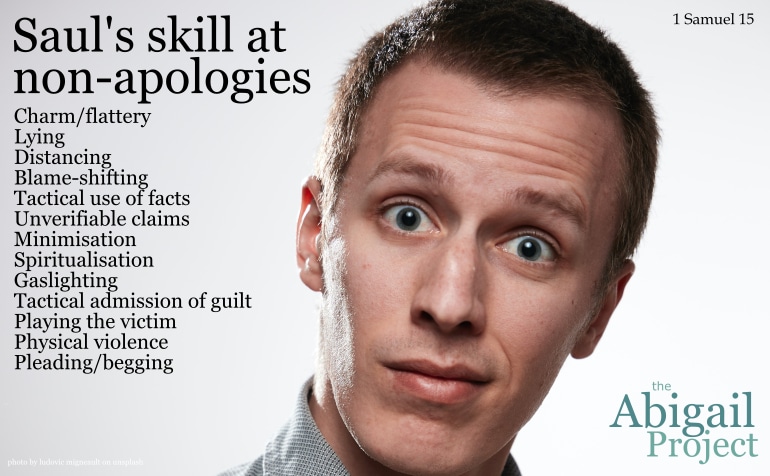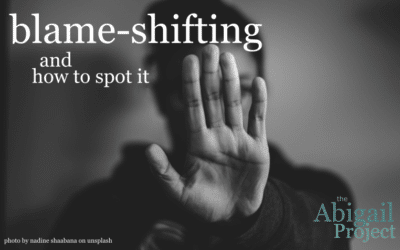As part of his armoury of abusive tactics, we can see Saul’s skill at non-apologies. If we understand his tactics, that can help us spot non-apologies in our own situations.
In our last few articles, we have been looking at some of the story of King Saul, and his son Jonathan. The few details we have of Saul’s life give us many examples of emotional and physical abuse, and one of his tactics was to avoid responsibility for his behaviour. Avoiding responsibility is a key feature of abuse. That hasn’t changed over millennia.
We have spent a little time looking at Saul’s blame-shifting tactics and what looks like narcissistic rage. But the goal of our journey here has been to explore the difference between non-apologies and true apologies.
One advantage of making a non-apology is that the abuser can claim to have apologised when they have done no such thing, and they can use that to their advantage in many ways. For example, a non-apologising abuser can paint their victims as unforgiving. That can help the abuser name themselves as the real victim, and garner support from flying monkeys who will – knowingly or unknowingly – join them in their abuse.
Saul’s behaviour is classic, and he uses a number of different tactics. Meanwhile, his son Jonathan shows remarkable ethical resilience. Jonathan does get taken in by Saul’s tactics at times, and sometimes dangerously so. Lives are at stake.1 However, the text seems to portray Jonathan as a person who is in the process of individuating from his father, centring his character and choices on his relationship with God and his own inner compass. While Saul finds most other people easy to manipulate and control – Jonathan is more resilient.
Saul was a practised liar
Our setting now is 1 Samuel 15. We find Saul off on a mission to destroy the Amalekites: a group of people who had attacked the Israelites many times before. Saul was unwilling to destroy the best of the livestock, and this choice becomes the focal point for his loss of the kingship.
What tactics does he use?
Saul’s skill at non-apologies was enhanced by his lies. Like many abusers, Saul was a practised liar. As soon as Samuel arrives on the scene, Saul says to him,
“The LORD bless you! I have carried out the LORD’s instructions.”2
Saul starts with a warm, spiritual greeting. He sounds like a decent guy: friendly, thoughtful, faithful, and Godly. It’s disarming. Yet we know God’s instructions had been clear, that Saul refused to follow them, and that Saul’s disobedience was not based on a misunderstanding, but on unwillingness. The text tells us back in verse 9:
But Saul and the army spared Agag and the best of the sheep and cattle, the fat calves and lambs—everything that was good. These they were unwilling to destroy completely, but everything that was despised and weak they totally destroyed.3
So it’s clear that Saul is lying here. I don’t think we can quite call it gaslighting yet, because it appears he is trying to hide his actions rather than change Samuel’s memory or confuse him about what has happened in the past. But the door to more manipulative behaviour is open.
Samuel, however, will have none of it. He has the advantage that God has already told him what happened.4 But he confronts Saul with physical evidence of his lie: the sheep and cattle are bleating and lowing in the background. Saul is found out.
Saul continued to lie despite clear evidence
Like many abusers, when faced with a challenge, even with undeniable evidence, Saul doubles down.
Saul answered, “The soldiers brought them from the Amalekites; they spared the best of the sheep and cattle to sacrifice to the LORD your God, but we totally destroyed the rest.”5
His first tactic, and, it seems, one of his favourites, is to distance himself and shift the blame. When he refers to anything questionable, he talks about other people doing it: “the soldiers”, or “they”. When he refers to anything ok, he includes himself: “we”. What other tactics does Saul use here?
- He offers a little piece of truth, helping him sound honest: “The soldiers brought them from the Amalekites.”
- Saul bases part of his defence on a future claim that can’t be proven or disproven: they only spared some sheep and cattle temporarily.
- He minimises the harm done: this is just a delay in timing, not an act of refusal, and it only affects part of the livestock.
- He spiritualises what he’s done. Based on his claim that the remaining livestock would be sacrificed to God – surely that’s good behaviour!
I think Saul’s response here is pretty smooth, and I suggest that takes practice. One can’t practice these tactics without it affecting one’s character, and I suggest that skilful application of abusive behaviour is a significant red flag well worth taking seriously. One does not become a skilled abuser overnight, and Saul’s skill at non-apologies is the same. In this single statement to Samuel, he uses at least half a dozen abusive tactics. That’s impressive.
What happens next?
Saul resorted to gaslighting rather than apologise
Samuel draws a line, and pushes back on Saul with a more detailed accusation, including a reminder of the initial instructions.
Samuel’s response is pretty direct:
“Why did you not obey the LORD?”6
But, rather than confess at this point, Saul digs deeper:
“But I did obey the LORD,” Saul said. “I went on the mission the LORD assigned me. I completely destroyed the Amalekites and brought back Agag their king. The soldiers took sheep and cattle from the plunder, the best of what was devoted to God, in order to sacrifice them to the LORD your God at Gilgal.”7
Now I believe Saul is edging into gaslighting by revising history. Both he and Samuel were present for the original instructions, and Samuel has just reiterated them. But Saul is claiming he did what was asked even though he left the king and some of the livestock alive. If he is successful, Samuel will be confused about what the agreement was, and let Saul off.
Gaslighting is not a simple skill. It takes effort to lie boldly and well when you and your audience know the truth. It takes practice to do that without looking like you are lying – you need to sound completely confident and not show signs of guilt or doubt. But it’s a very effective technique if done well, and his expertise in lying really helped Saul’s skill at non-apologies.
It’s not the only tactic Saul uses here. Again, he takes credit for anything that sounds good and shifts the blame to his men for anything that sounds bad. He repeats his minimisation and spiritualisation of his and their behaviour – claiming they only delayed destroying the livestock, and that they did so for Godly reasons.
Saul only admitted fault to escape consequences
Saul’s tactics continue not to work with Samuel, who explains the consequences:
Because you have rejected the word of the LORD,
he has rejected you as king.”8
It’s at this point Saul finally states he had sinned. However, his confession is suspect, as it appears more likely to be an attempt to avoid consequences than to be an expression of remorse or true admission of guilt.
Saul starts by saying,
“I have sinned. I violated the LORD’s command and your instructions.”9
That sounds like a good start, but then he changes focus:
I was afraid of the men and so I gave in to them. Now I beg you, forgive my sin and come back with me, so that I may worship the LORD.”10
He has not stopped shifting the blame to his men but now takes a more active victim role. He seeks to legitimate his actions because he was afraid of the men. At worst, he is now painting his disobedience as an understandable fear response.
Saul’s skill at non-apologies included violence
As Samuel refuses to buy into Saul’s tactics, Saul escalates his behaviour, resorting to violence in attempting to physically restrain Samuel:
But Samuel said to him, “I will not go back with you. You have rejected the word of the LORD, and the LORD has rejected you as king over Israel!”
As Samuel turned to leave, Saul caught hold of the hem of his robe, and it tore.11
Without being there to see the details, we can’t be sure what level of violence was involved. We could guess that if the material was weak, it wouldn’t have taken much to tear Samuel’s robe. For a well-made robe, it might have taken quite some effort. However, we are at least left with the picture that Saul, as a much stronger and younger man, used unwelcome force to prevent Samuel from leaving.
Ultimately, Saul’s skill at non-apologies helped him reduce consequences for himself
Finally, Saul tries again to avoid the consequences of his behaviour, and has some success:
Saul replied, “I have sinned. But please honour me before the elders of my people and before Israel; come back with me, so that I may worship the LORD your God.”
So Samuel went back with Saul, and Saul worshipped the LORD.12
One of the features of a true apology is a clear desire to set things right and repair harm. In this situation, a public apology would be completely appropriate, given the way Saul’s choices affected those he was leading. But rather than do that, Saul pleads with Samuel to preserve his reputation. He cared more about the consequences to himself than he did about the harm he’d done.
Was Samuel rattled by Saul’s aggression?
I don’t believe it’s clear from the text here whether God approved of Samuel relenting a little at this point. Perhaps he did. It’s possible Samuel was rattled by the physical altercation, and we see in the very next chapter that he is afraid Saul will kill him, saying:
But Samuel said, “How can I go? If Saul hears about it, he will kill me.”
The LORD said, “Take a heifer with you and say, ‘I have come to sacrifice to the LORD.’13
In that case, God appears to agree that Saul is dangerous, and instructs Samuel to use misdirection in order to stay safe. But looking at this story of Saul’s disobedience, it seems that Saul’s skill at non-apologies, while not enough to completely deflect Samuel, was enough to at least reduce some of the consequences to himself. He got away with what he’d done – partly. And we know he still lost the kingship, but not for a long time yet.
One of the features of a true apology is a clear desire to set things right and repair harm. Share on X
Saul’s skill at non-apologies required many different techniques
Saul’s skill at non-apologies is backed by his effective use of so many emotional abuse techniques. He uses more than a dozen different tactics, including at least:
- Charm/flattery and an appearance of Godliness: “The LORD bless you!”
- Lying
- Distancing
- Blame-shifting
- Tactical use of facts
- Unverifiable claims about his intent
- Minimisation
- Spiritualisation
- Gaslighting
- Apparent admission of guilt to avoid consequences
- Playing the victim
- Physical violence
- Pleading/begging to avoid consequences
These behaviours come out during a number of opportunities for Saul to sincerely apologise and take responsibility for his behaviour and the harm he has done.
Saul’s behaviour is not unusual for abusers, who might have dozens of abusive tactics to draw on. It illustrates some of the difficulty of dealing with abusers, and why a non-apology can be so effective. Each of these tactics helps the abuser win, and it takes awareness to spot them. Samuel appears to have had pretty decent emotional and social intelligence, but we also know in this situation he had been warned by God and armed with facts.
Some good news for us is we can get to know stories like this one and they can help us spot this kind of behaviour in others. It takes some effort, but it is achievable. Every time we gain skill in spotting one of these behaviours: that’s progress worth celebrating.
Steve Wade
Saul's skill at non-apologies is backed by his effective use of so many emotional abuse techniques. Share on XBefore you go…
Abuse can be paralyzing and confusing. But we can help people spot abusive behaviour and do something about it.
For that – we need your help!
Please will you help us in the fight against abuse by donating now?





Wow! I found this site while searching for answers in relating with my narcissistic mother. It’s so spot-on, and I can now see some of the tactics she has been using to manipulate me and others. I’m relieved to see that I’m not crazy after all I’ve only been emotionally abused for a really long time.
Hi Mercy – I’m so glad we can help.
Emotional abuse can be so devious and confusing. Abusers often have so many different behaviours in their toolbags, it’s hard to keep track of. I really hope you can get some space from all that.
My apologies for not replying earlier – I’ve been missing the comment notifications 😐